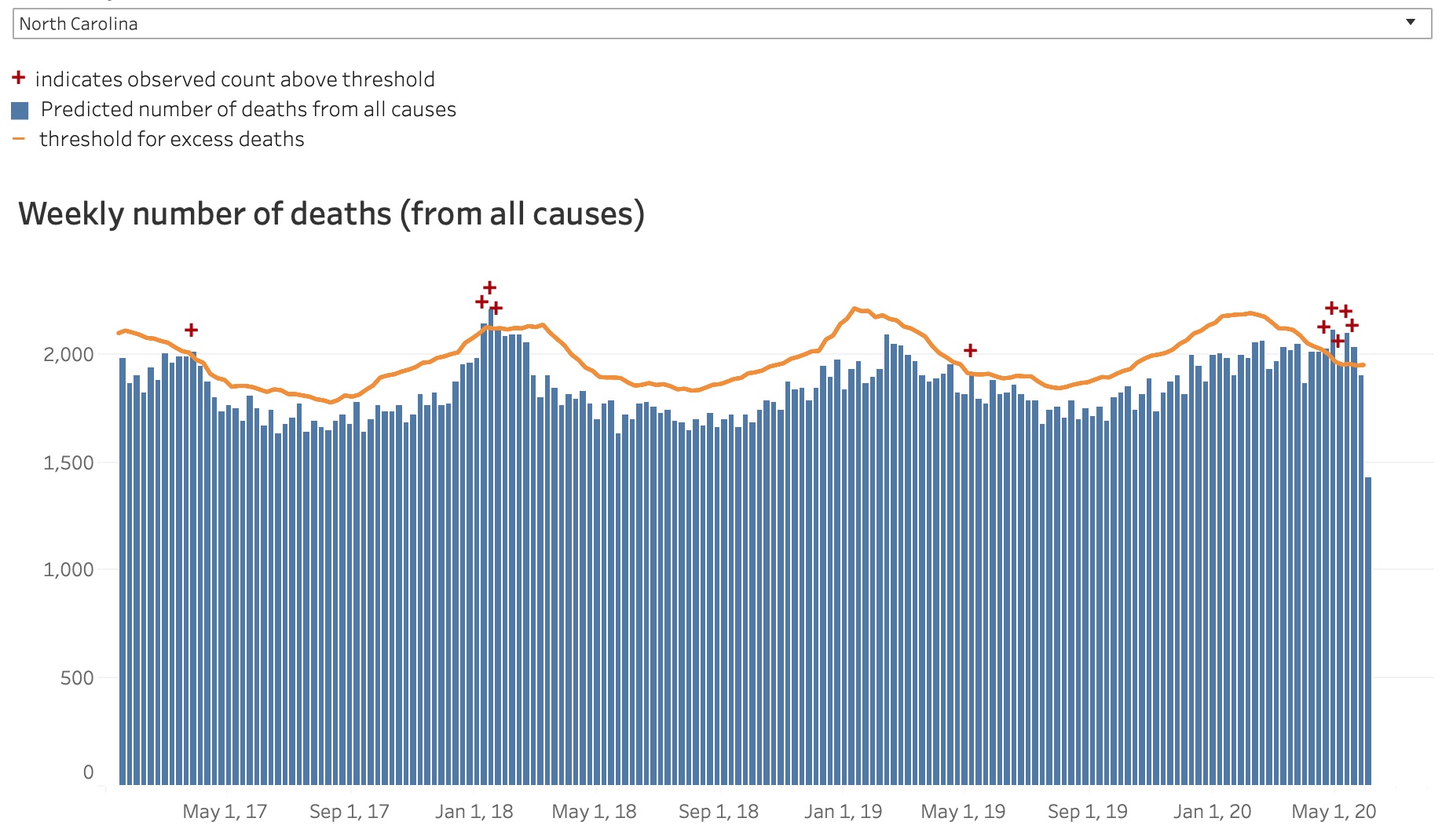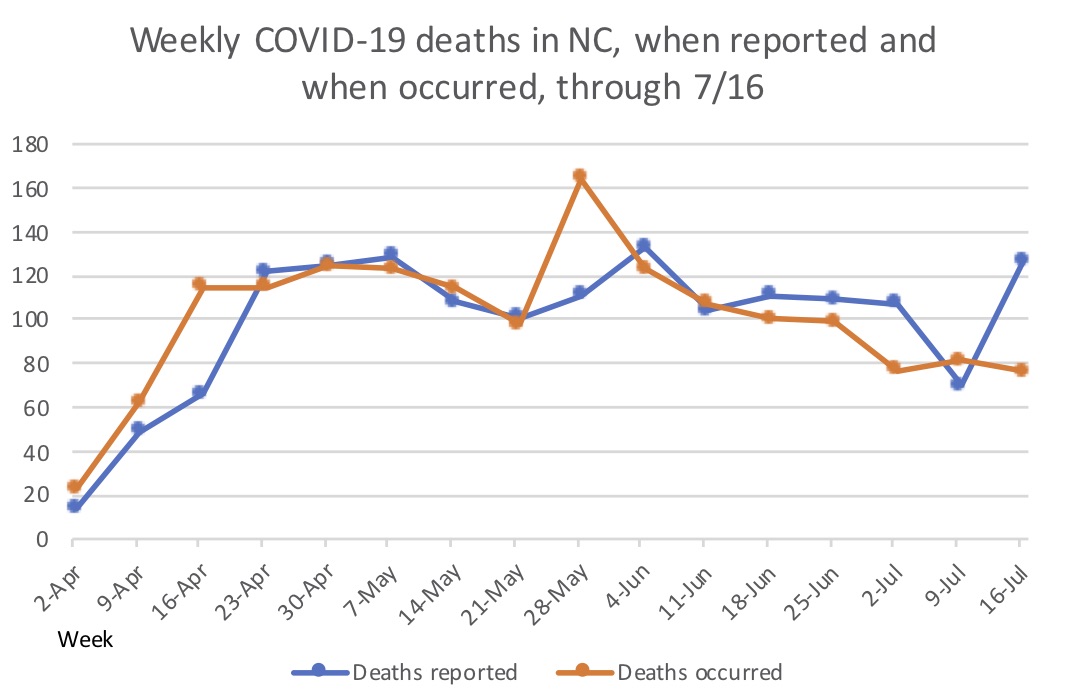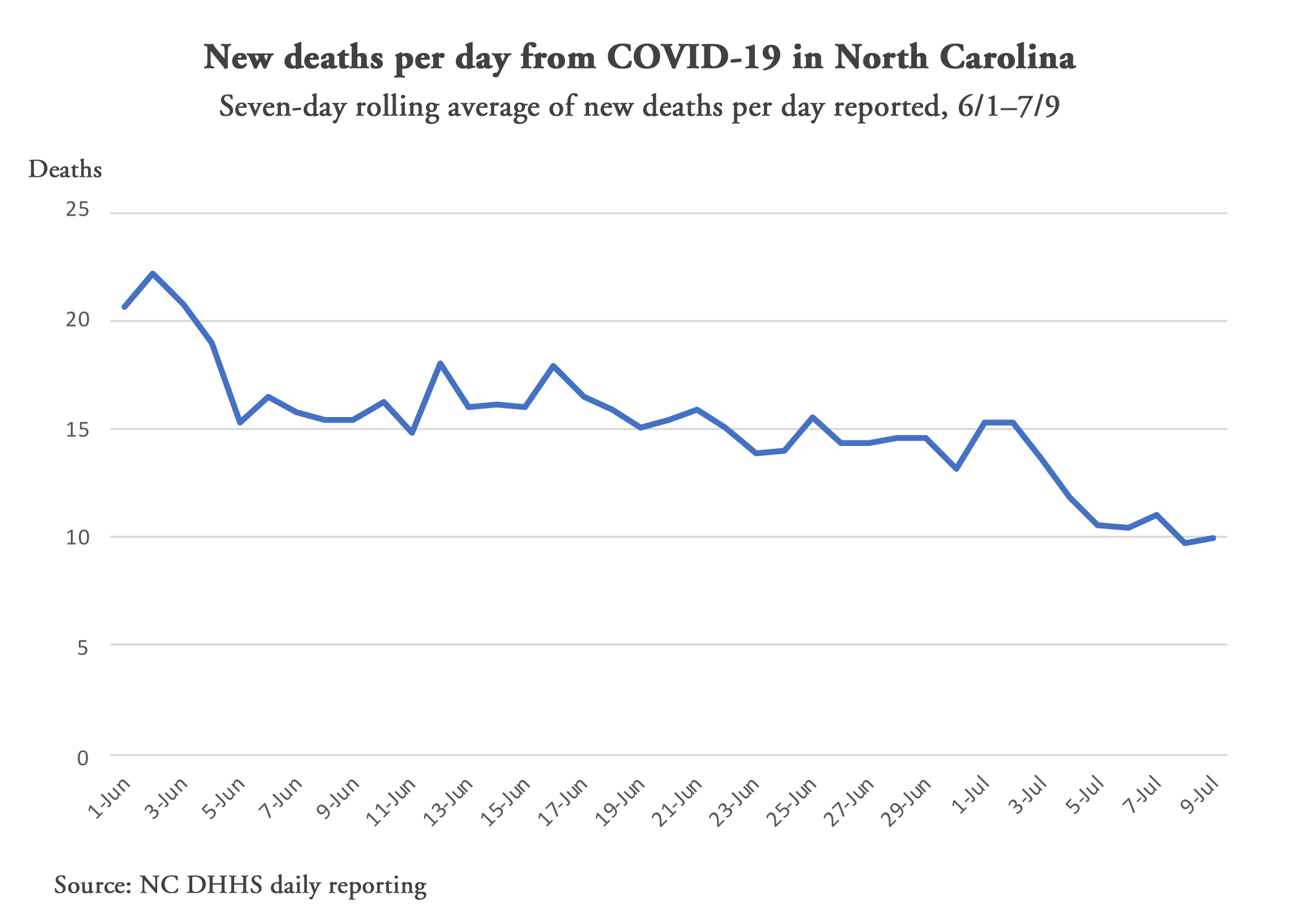Given doubts about the quality of COVID-19 data collection, it’s very useful to know whether a state is witnessing more deaths than usual. All the more so when the fear of hospital overruns and widespread death are the basis for severe, government-imposed economic and personal restrictions.
So, it’s baffling why North Carolina is the absolute worst in the nation in reporting “excess deaths” data to the Centers for Disease Control and Prevention (CDC).
The CDC’s Excess Deaths Associated with COVID-19 dashboard is a valuable tool for helping pinpoint an unusual outbreak of deaths in a part of the country, regardless of the reason for the fatalities. It tracks a state’s average number of deaths at a point in time, estimated over a number of years, and predicts the “expected deaths” for that period in the future.
Of course, actual deaths will differ from a statistical prediction of expected deaths. As long as the actual deaths are below a 95 percent confidence interval for expected deaths, the CDC reckons there are no unusual causes of deaths during that period. If actual deaths exceed that threshold, however, those “excess deaths” alert the CDC that there is an unusual cause of death in that jurisdiction.
A pandemic like COVID-19 or a particularly bad outbreak of influenza could push a state into “excess deaths” territory. What makes this method so useful is that it doesn’t worry about judgment calls over the actual causes of deaths. It compares total deaths in a state during a period with the history of deaths in that state at that same time of the year. It isn’t affected by uncertainties over the classification of deaths from a pandemic like COVID-19 or the flu. (For more information about classification issues, see Dr. Donald R. van der Vaart’s discussion of the potential mixup in determining the cause of death from COVID-19, flu, and pneumonia.)
Deaths in North Carolina
The last week for which the state Department of Health and Human Services (DHHS) under Secretary Mandy Cohen has reported North Carolina death data to the CDC is May 30. NC is dead last in the nation in reporting these data. It’s not even close.
North Carolina is over a month behind all but two other states and territories. Our closest competitors in lax reporting are Connecticut and West Virginia, which are still two weeks ahead of us (updated through June 13). All the other states have reported death data through July 4.
Here is North Carolina’s excess deaths chart from the CDC as of July 20 (or click this interactive link):

From data reported to-date to the CDC, North Carolina exceeded the excess death threshold across five weeks from early April to mid-May. Deaths are a lagging indicator of the virus by about three weeks after exposure. So those fatal COVID-19 cases were likely contracted around mid-March through late April.
DHHS reports fatalities as part of its daily COVID-19 data releases, but those deaths aren’t all new deaths that day; they are deaths DHHS has learned of that day. There’s a difference in when a death occurs and when DHHS reports it. See this post for more discussion, but here is a recent graph that shows the difference:

Here is a graph using DHHS data as of July 20 showing COVID-19 deaths in North Carolina (using a seven-day rolling average to smooth the data). Deaths were high and stable from mid-April through mid-May, coinciding with the weeks showing excess deaths. There’s a dip followed by a spike at the end of May. Then there’s a sharper decline across June into mid-July:

Excess deaths from COVID-19 in NC after May 30
While concerned citizens everywhere else across America can have an idea of whether their particular jurisdictions experienced excess deaths in June, North Carolinians under Gov. Roy Cooper’s perpetual “Phase 2” restrictions still can’t. It’s possible, however, to estimate whether North Carolina witnessed excess deaths in June owing specifically to COVID-19. Here’s how.
The CDC has already projected through June 27 the expected deaths for North Carolina by week, as well as the upper bound thresholds for each week beyond which excess deaths would be thought to occur. (See the “Options” section to download “National and State Estimates of Excess Deaths.”) The difference between the upper bound and expected deaths each week gives the number of deaths to compare against that week’s count of COVID-19 deaths. If the number of COVID-19 deaths is higher, then it would mean that there would likely be excess deaths that week owing to COVID-19.
For example, for the first week during which NC experienced excess deaths from all causes (the week ending April 18), the difference between the upper bound (2018) and expected deaths (1888) was 130. The number of COVID-19 deaths during that week was 133.
Starting from the end of May through June, here are differences by week in the CDC upper bound threshold and the CDC’s expected deaths for North Carolina:
May 30: 129
June 6: 123
June 13: 115
June 20: 121
June 27: 126
Here are the corresponding counts of COVID-19 deaths in North Carolina, using deaths by date occurred per DHHS:
May 30: 160 (+31)
June 6: 123 (even)
June 13: 103 (–12)
June 20: 96 (–25)
June 27: 92 (–34)
From this simple exercise, it seems likely that COVID-19 deaths put North Carolina in excess deaths territory on the weeks ending May 30 and June 6. Subsequent weeks look increasingly unlikely to expect excess deaths in North Carolina, at least not owing to COVID-19.
Concluding thoughts
For North Carolina to be last by a country mile in reporting deaths data is perplexing. Why is Secretary Cohen not reporting these critical data to the CDC?
What if, by reporting deaths like other states have been doing, DHHS would also be showing that North Carolina isn’t experiencing excess deaths due to COVID-19? Would such data disclosure undermine justifications for the Cooper administration’s harsh and protracted business shutdowns, half-shutdowns, K-12 disruptions, and severe economic and personal restrictions?


